Thermal Analysis of THz Schottky Diode Chips with Single and Double-Row Anode Arrangement
Abstract
:1. Introduction
2. Thermal Simulation for Schottky Diode Chips
3. Results and Discussion
4. Effect of Substrate on Thermal Characteristics of SBD
5. Conclusions
Author Contributions
Funding
Data Availability Statement
Conflicts of Interest
References
- Petrov, V.; Pyattaev, A.; Moltchanov, D.; Koucheryavy, Y. Terahertz Band Communications: Applications, Research Challenges, and Standardization Activities. In Proceedings of the 2016 8th International Congress on Ultra Modern Telecommunications and Control Systems and Workshops (ICUMT), Lisbon, Portugal, 18–20 October 2016; pp. 183–190. [Google Scholar]
- Chattopadhyay, G. Technology, Capabilities, and Performance of Low Power Terahertz Sources. IEEE Trans. Terahertz Sci. Technol. 2011, 1, 33–53. [Google Scholar] [CrossRef]
- Song, H.-J.; Nagatsuma, T. Present and Future of Terahertz Communications. IEEE Trans. Terahertz Sci. Technol. 2011, 1, 256–263. [Google Scholar] [CrossRef]
- Zhang, Y.; Wu, C.; Liu, X.; Wang, L.; Dai, C.; Cui, J.; Li, Y.; Kinar, N. The Development of Frequency Multipliers for Terahertz Remote Sensing System. Remote Sens. 2022, 14, 2486. [Google Scholar] [CrossRef]
- Kiuru, T.; Chattopadhyay, G.; Reck, T.J.; Minnich, A.J.; Lin, R.; Schlecht, E.; Siles, J.V.; Lee, C.; Mehdi, I. Thermal Characterization of Substrate Options for High-Power THz Multipliers Over a Broad Temperature Range. IEEE Trans. Terahertz Sci. Technol. 2016, 6, 328–335. [Google Scholar] [CrossRef]
- Dong, Y.; Liang, H.; Liang, S.; Zhou, H.; Yu, J.; Guo, H.; Zeng, H.; Feng, Z.; Zhang, Y. High-Efficiency GaN Frequency Doubler Based on Thermal Resistance Analysis for Continuous Wave Input. IEEE Trans. Electron Devices 2023, 70, 4565–4571. [Google Scholar] [CrossRef]
- Chvala, A.; Donoval, D.; Satka, A.; Molnar, M.; Marek, J.; Pribytny, P. Advanced Methodology for Fast 3-D TCAD Device/Circuit Electrothermal Simulation and Analysis of Power HEMTs. IEEE Trans. Electron Devices 2015, 62, 828–834. [Google Scholar] [CrossRef]
- Nadri, S.; Moore, C.M.; Sauber, N.D.; Xie, L.; Cyberey, M.E.; Gaskins, J.T.; Lichtenberger, A.W.; Scott Barker, N.; Hopkins, P.E.; Zebarjadi, M.; et al. Thermal Characterization of Quasi-Vertical GaAs Schottky Diodes Integrated on Silicon. IEEE Trans. Electron Devices 2019, 66, 349–356. [Google Scholar] [CrossRef]
- Nadri, S.; Xie, L.; Alijabbari, N.; Gaskins, J.T.; Foley, B.M.; Hopkins, P.E.; Weikle II, R.M. Steady-State Thermal Analysis of an Integrated 160 GHz Balanced Quadrupler Based on Quasi-Vertical Schottky Diodes. In Proceedings of the 2015 40th International Conference on Infrared, Millimeter, and Terahertz waves (IRMMW-THz), Hong Kong, China, 23–28 August 2015; pp. 1–2. [Google Scholar]
- Li, X.; Pu, T.; Li, L.; Ao, J.-P. Enhanced Sensitivity of GaN-Based Temperature Sensor by Using the Series Schottky Barrier Diode Structure. IEEE Electron Device Lett. 2020, 41, 601–604. [Google Scholar] [CrossRef]
- An, N.; Li, L.; Wang, W.; Xu, X.; Zeng, J. High-Efficiency D-Band Monolithically Integrated GaN SBD-Based Frequency Doubler With High Power Handling Capability. IEEE Trans. Electron Devices 2022, 69, 4843–4847. [Google Scholar] [CrossRef]
- Liu, H.; Liang, Z.; Meng, J.; Liu, Y.; Wang, H.; Yan, C.; Wu, Z.; Liu, Y.; Zhang, D.; Wang, X.; et al. 120 GHz Frequency-Doubler Module Based on GaN Schottky Barrier Diode. Micromachines 2022, 13, 1172. [Google Scholar] [CrossRef] [PubMed]
- Zhang, L.; Liang, S.; Lv, Y.; Yang, D.; Fu, X.; Song, X.; Gu, G.; Xu, P.; Guo, Y.; Bu, A.; et al. High-Power 300 GHz Solid-State Source Chain Based on GaN Doublers. IEEE Electron Device Lett. 2021, 42, 1588–1591. [Google Scholar] [CrossRef]
- Sodan, V.; Stoffels, S.; Oprins, H.; Decoutere, S.; Altmann, F.; Baelmans, M.; De Wolf, I. Fast and Distributed Thermal Model for Thermal Modeling of GaN Power Devices. IEEE Trans. Compon. Packag. Manuf. Technol. 2018, 8, 1747–1755. [Google Scholar] [CrossRef]
- Kim, T.; Song, C.; Park, S.I.; Lee, S.H.; Lee, B.J.; Cho, J. Modeling and Analyzing Near-Junction Thermal Transport in High-Heat-Flux GaN Devices Heterogeneously Integrated with Diamond. Int. Commun. Heat Mass Transf. 2023, 143, 106682. [Google Scholar] [CrossRef]
- Huang, Q.; Chen, W. Electro-Thermal Simulation of GaN HEMT by Finite Element Method. In Proceedings of the 2023 International Applied Computational Electromagnetics Society Symposium (ACES-China), Hangzhou, China, 15–18 August 2023; pp. 1–3. [Google Scholar]
- Risbud, D.M.; Pedrotti, K.; Power, M.; Pomeroy, J.W.; Kuball, M. Thermal Characterization of High Voltage GaN-on-Si Schottky Barrier Diodes (SBD) for Designing an on-Chip Thermal Shutdown Circuit for a Power HEMT. In Proceedings of the 2015 IEEE 3rd Workshop on Wide Bandgap Power Devices and Applications (WiPDA), Blacksburg, VA, USA, 2–4 November 2015; pp. 156–161. [Google Scholar]
- Tang, A.Y.; Schlecht, E.; Lin, R.; Chattopadhyay, G.; Lee, C.; Gill, J.; Mehdi, I.; Stake, J. Electro-Thermal Model for Multi-Anode Schottky Diode Multipliers. IEEE Trans. Terahertz Sci. Technol. 2012, 2, 290–298. [Google Scholar] [CrossRef]
- Perez-Moreno, C.G.; Grajal, J.; Viegas, C.; Liu, H.; Powell, J.; Alderman, B. Thermal Analysis of High-Power Millimeter-Wave Schottky Diode Frequency Multipliers. In Proceedings of the 2016 Global Symposium on Millimeter Waves (GSMM) & ESA Workshop on Millimetre-Wave Technology and Applications, Espoo, Finland, 6–8 June 2016; pp. 1–4. [Google Scholar]
- Cui, J.; Zhang, Y.; Wei, H.; Wu, Q.; Mao, S.; Xu, Y.; Yan, B.; Xu, R. Electro-Thermal Model for Schottky Barrier Diode Based on Self-Heating Effect. In Proceedings of the 2021 IEEE 4th International Conference on Electronics and Communication Engineering (ICECE), Xi’an, China, 17–19 December 2021; pp. 330–334. [Google Scholar]
- Song, X.; Zhang, L.; Liang, S.; Tan, X.; Zhang, Z.; Gao, N.; Zhang, Y.; Lv, Y.; Feng, Z. Thermal Analysis of GaN Schottky Diodes in the Terahertz Frequency Multipliers. In Proceedings of the 2019 IEEE International Conference on Electron Devices and Solid-State Circuits (EDSSC), Xi’an, China, 12–14 June 2019; pp. 1–2. [Google Scholar]
- Mitterhuber, L.; Leitgeb, V.; Krainz, M.; Strauss, R.; Kaden, T.; Treidel, E.B.; Brunner, F.; Huber, C.; Kraker, E. Thermal Management of Vertical GaN Transistors. In Proceedings of the 2023 24th International Conference on Thermal, Mechanical and Multi-Physics Simulation and Experiments in Microelectronics and Microsystems (EuroSimE), Utrecht, The Netherlands, 6–9 April 2023; pp. 1–8. [Google Scholar]
- Chen, X.; Tang, D. Thermal Simulations in GaN HEMTs Considering the Coupling Effects of Ballistic-Diffusive Transport and Thermal Spreading. IEEE Trans. Compon. Packag. Manuf. Technol. 2023, 13, 1929–1943. [Google Scholar] [CrossRef]
- Cho, J.; Li, Z.; Bozorg-Grayeli, E.; Kodama, T.; Francis, D.; Ejeckam, F.; Faili, F.; Asheghi, M.; Goodson, K.E. Thermal Characterization of GaN-on-Diamond Substrates for HEMT Applications. In Proceedings of the 13th InterSociety Conference on Thermal and Thermomechanical Phenomena in Electronic Systems, San Diego, CA, USA, 30 May–1 June 2012; pp. 435–439. [Google Scholar]
- Killat, N.; Montes, M.; Pomeroy, J.W.; Paskova, T.; Evans, K.R.; Leach, J.; Li, X.; Ozgur, U.; Morkoc, H.; Chabak, K.D.; et al. Thermal Properties of AlGaN/GaN HFETs on Bulk GaN Substrates. IEEE Electron Device Lett. 2012, 33, 366–368. [Google Scholar] [CrossRef]


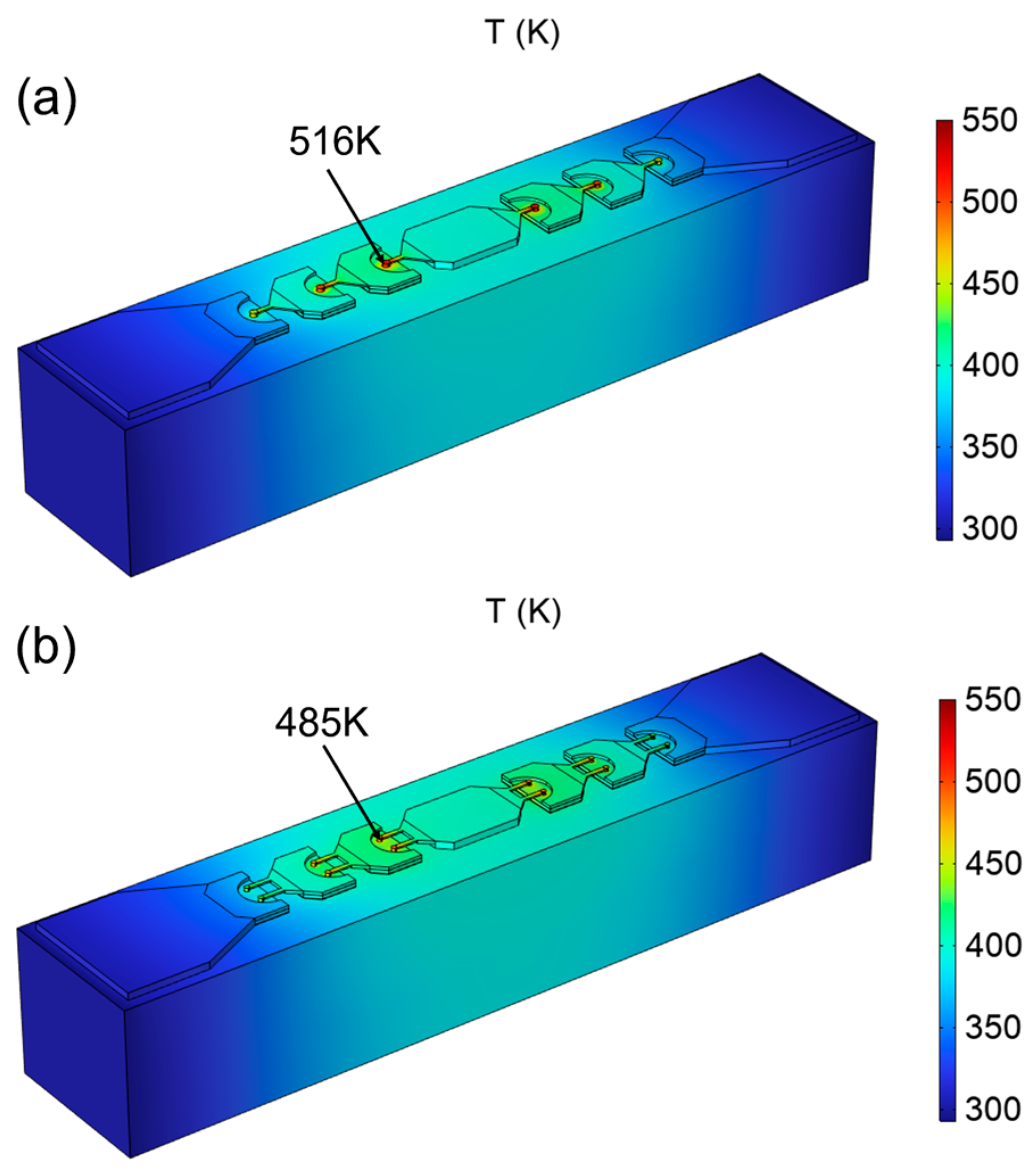
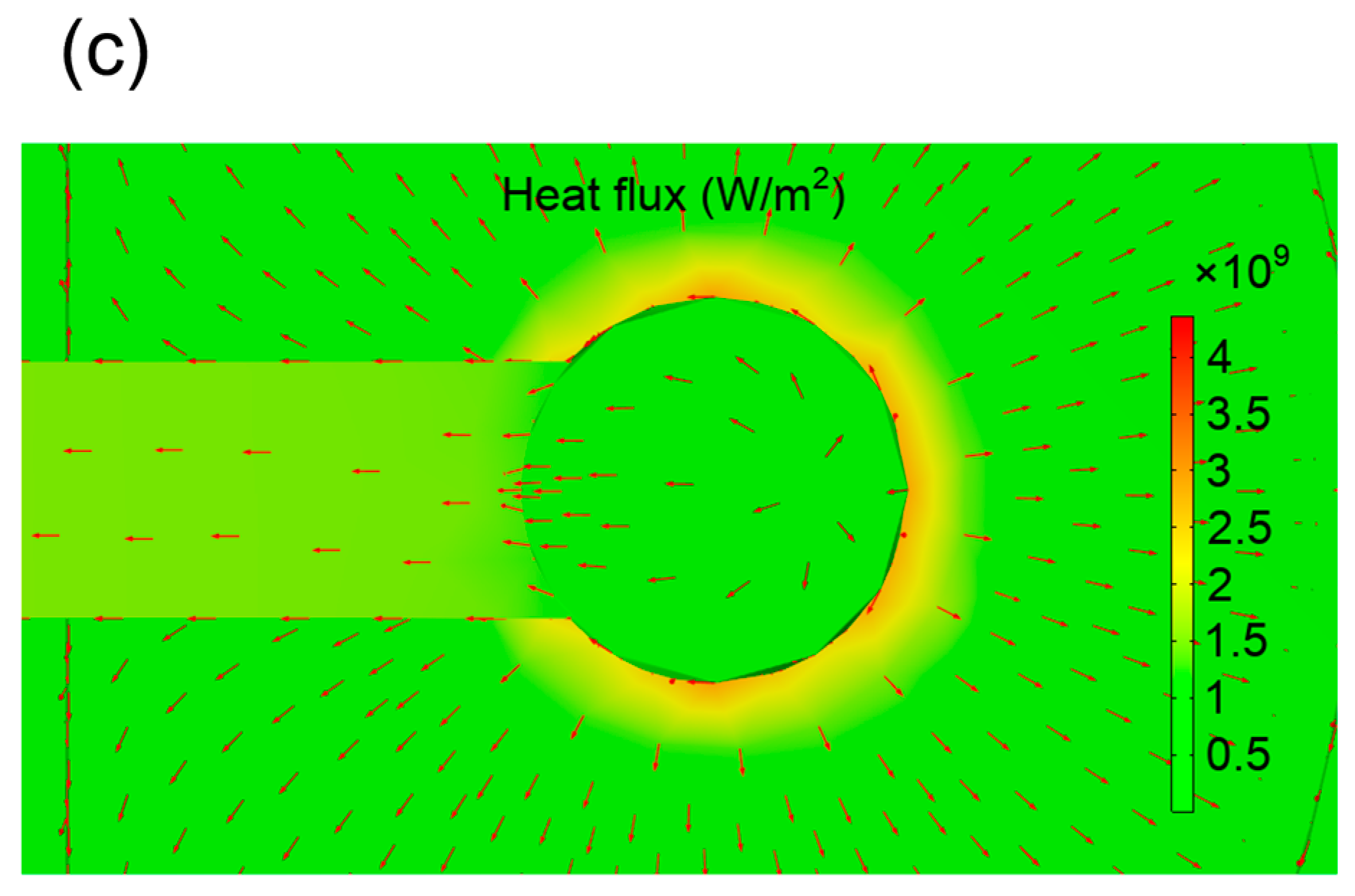
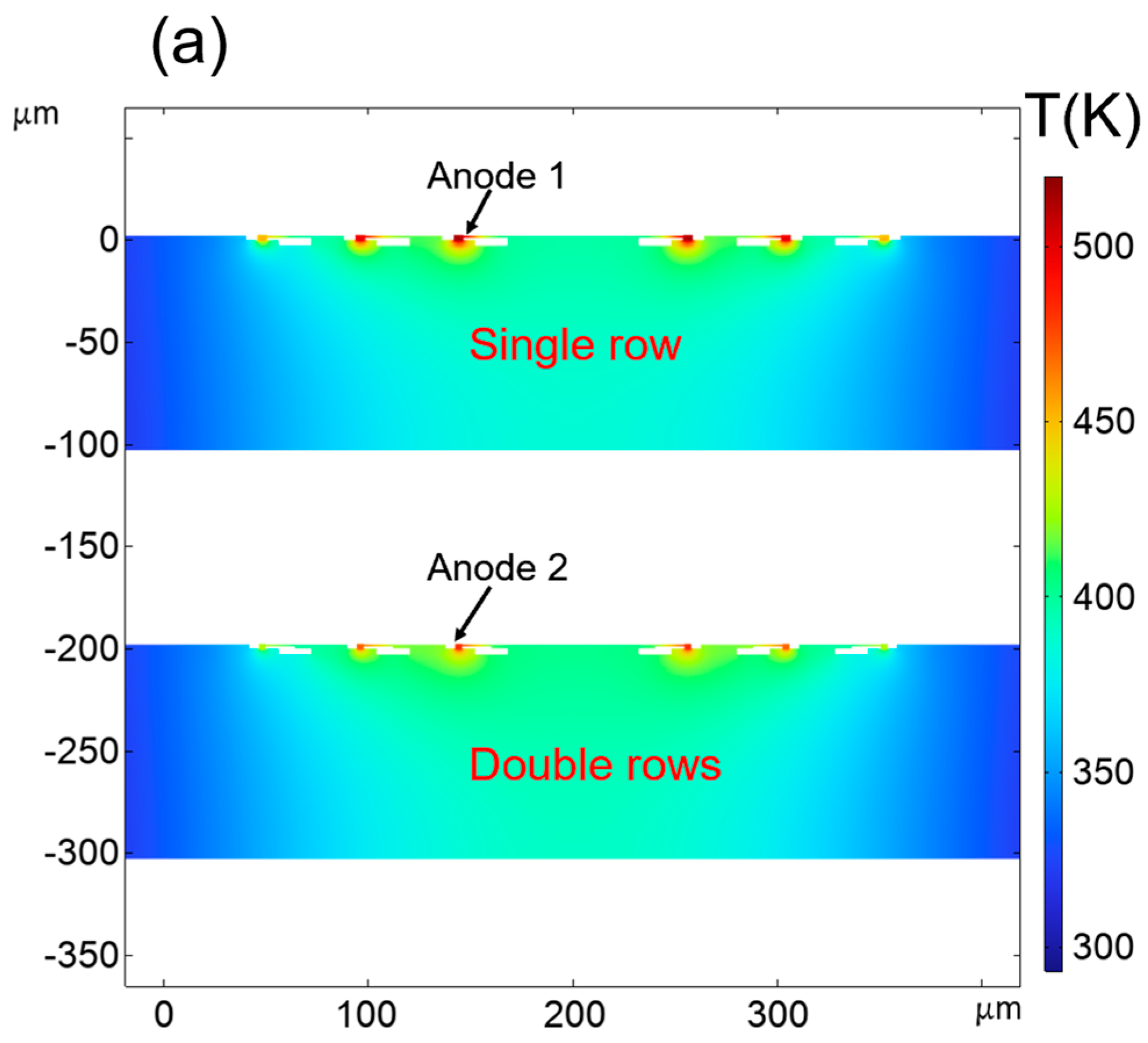

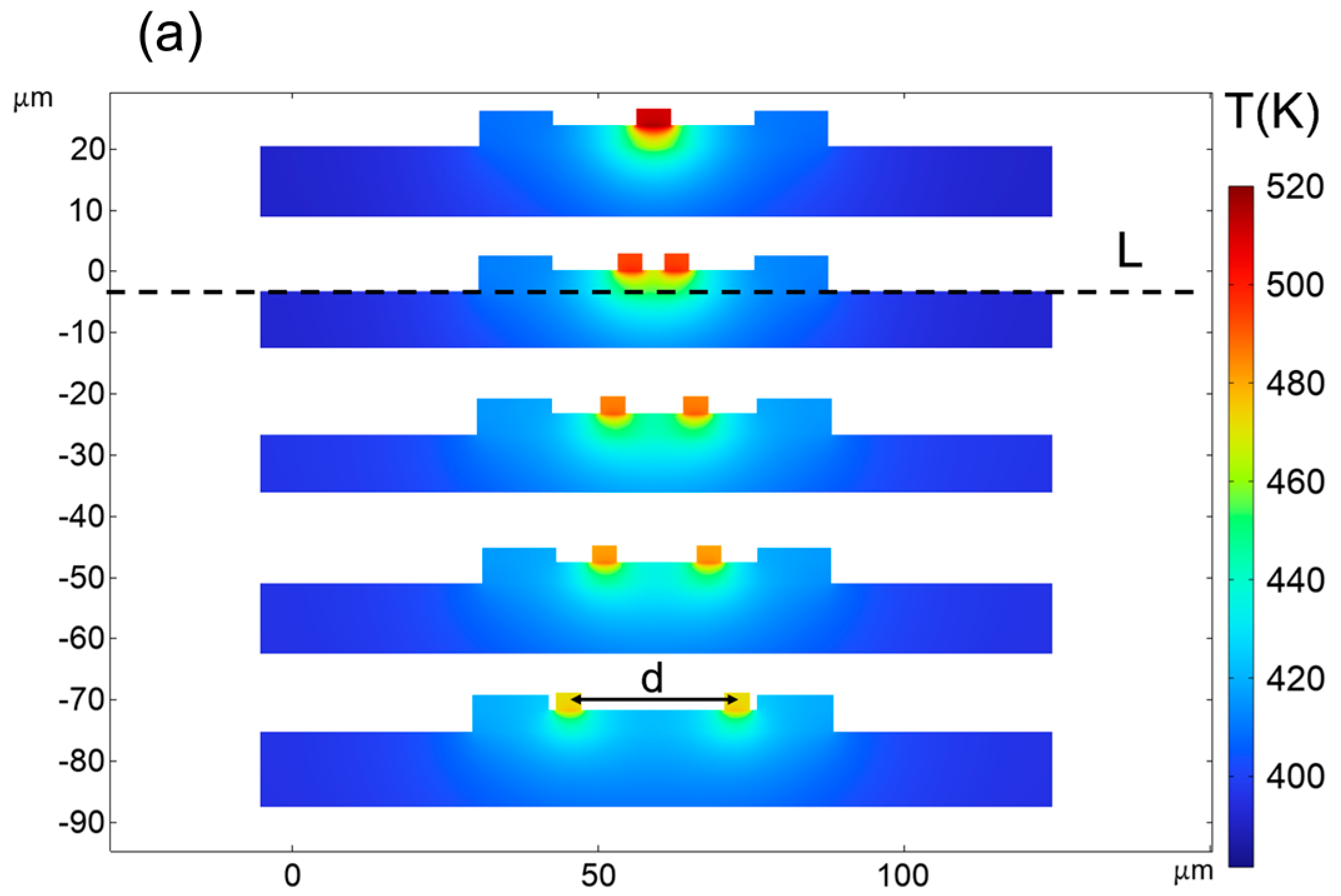
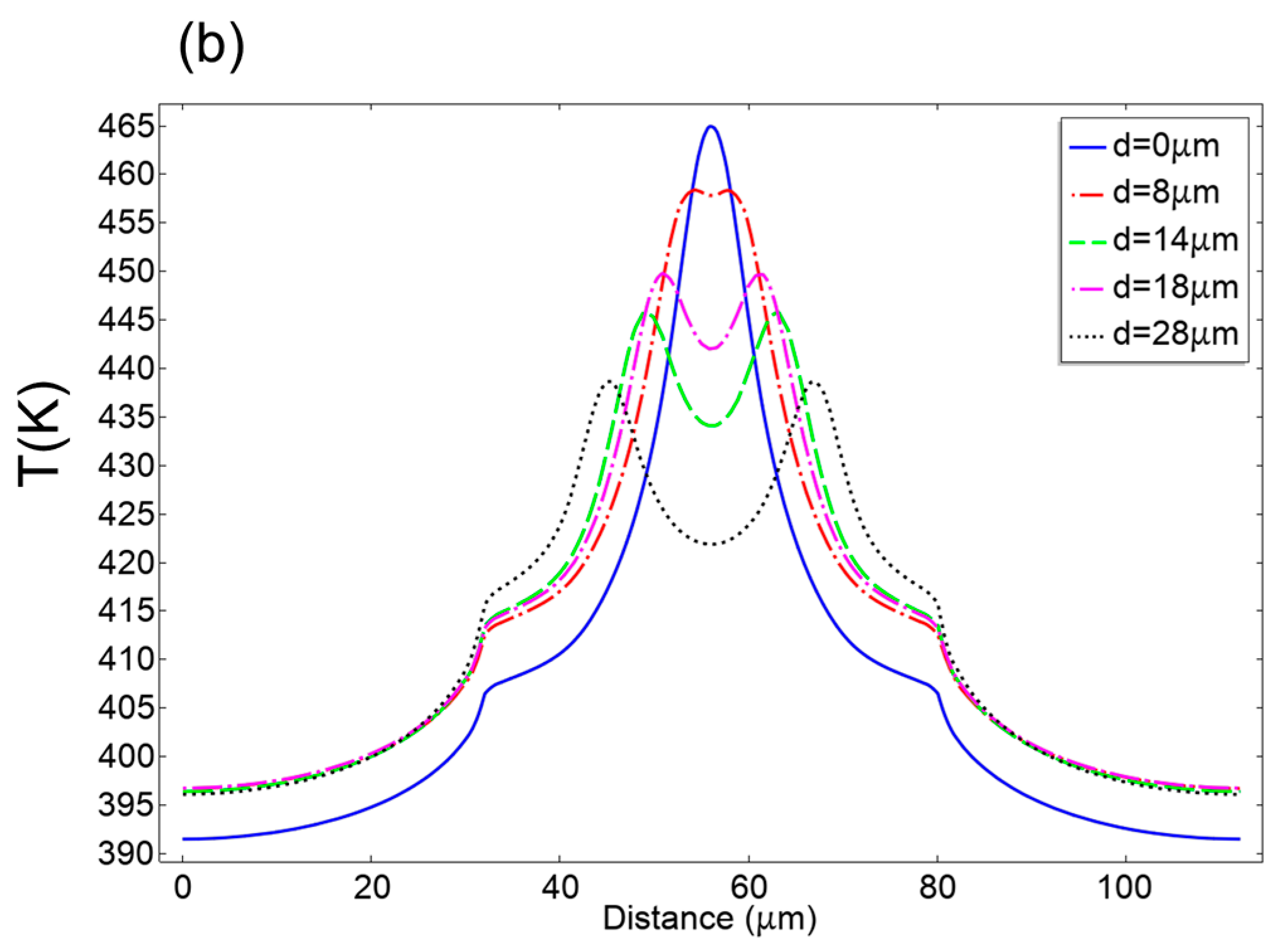
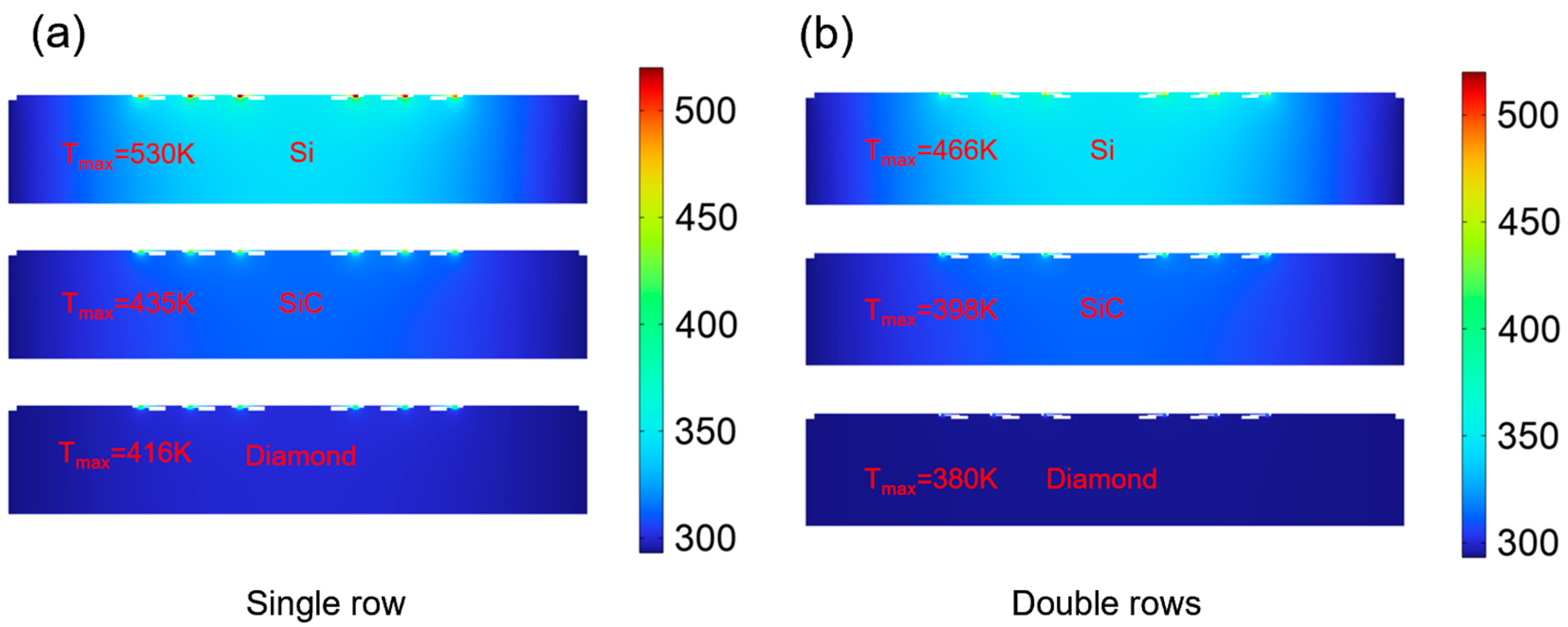
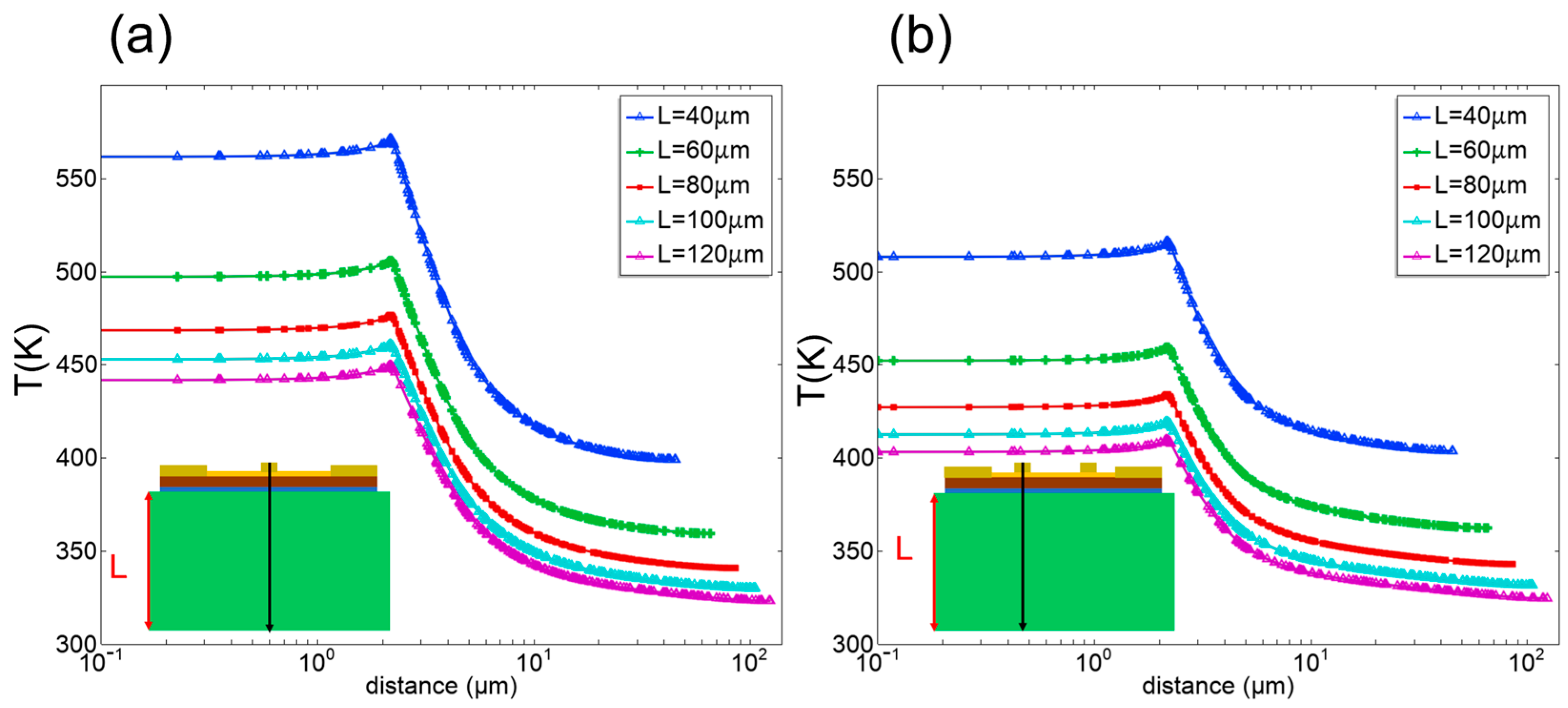


| Material | Thermal Conductivity (W/mK) | Electric Conductivity (S/m) |
|---|---|---|
| Au | 317 | |
| n−-GaN | 157 × (300/T)1.9 | 560 |
| n+-GaN | 157 × (300/T)1.9 | |
| buffer layer | 157 × (300/T)1.9 | 0.01 |
| Si | 160 × (300/T)1.5 | - |
| sapphire | 35 × (300/T) | - |
| SiC | 400 × (300/T) | - |
| Diamond | 1100 | - |
Disclaimer/Publisher’s Note: The statements, opinions and data contained in all publications are solely those of the individual author(s) and contributor(s) and not of MDPI and/or the editor(s). MDPI and/or the editor(s) disclaim responsibility for any injury to people or property resulting from any ideas, methods, instructions or products referred to in the content. |
© 2024 by the authors. Licensee MDPI, Basel, Switzerland. This article is an open access article distributed under the terms and conditions of the Creative Commons Attribution (CC BY) license (https://creativecommons.org/licenses/by/4.0/).
Share and Cite
Liu, Z.; Zhang, X.; Liang, Z.; Wang, F.; Xu, Y.; Yang, X.; Li, X.; Liang, Y.; Lin, L.; Li, X.; et al. Thermal Analysis of THz Schottky Diode Chips with Single and Double-Row Anode Arrangement. Micromachines 2024, 15, 959. https://doi.org/10.3390/mi15080959
Liu Z, Zhang X, Liang Z, Wang F, Xu Y, Yang X, Li X, Liang Y, Lin L, Li X, et al. Thermal Analysis of THz Schottky Diode Chips with Single and Double-Row Anode Arrangement. Micromachines. 2024; 15(8):959. https://doi.org/10.3390/mi15080959
Chicago/Turabian StyleLiu, Zenghui, Xiaobo Zhang, Zhiwen Liang, Fengge Wang, Yanyan Xu, Xien Yang, Xin Li, Yisheng Liang, Lizhang Lin, Xiaodong Li, and et al. 2024. "Thermal Analysis of THz Schottky Diode Chips with Single and Double-Row Anode Arrangement" Micromachines 15, no. 8: 959. https://doi.org/10.3390/mi15080959




